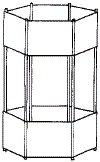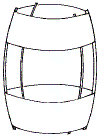By Leslie Hunt

FIG. 39.
SKETCHES OF UPRIGHT AND DIAGONAL STICKS OF THE SQUARE BOX KITE
The history of the Square Box Kite is full of interest to all kite makers. The box kite was invented, about 1892, by Hargrave, an Australian, who later hoped to develop the kite for lifting observers. The idea was not new, as the Chinese and Japanese both have stories of man-lifting kites of great antiquity. While man-lifting kites have been made and tried for military purposes, the principal value of the box kite lies in its use for studying the conditions of the upper atmosphere.
It is interesting to note that the Western people in the space of twenty years, invented and perfected a much better kite when they developed the box kite, than the Eastern peoples, long regarded as expert kite makers, have done in twenty centuries. The rectangular box kite is the usual type used for scientific purposes, but the square box still remains a great favorite for amusement.
The proportions, 12 by 12 by 26 inches with paper 7 inches wide, are ideal. Reinforcement is hardly necessary if good quality, light-weight wrapping paper is used. A string dipped in thin glue and applied to the paper will give enough reinforcement should any be found necessary.
Prepare four sticks 1/8 by 3/8 by 26 inches and four others 1/8 by 3/8 by 17&1/2 inches. Glue chips on the long sticks and notch the short sticks as shown in Figure 39.
Prepare two strips of paper, 7 by 49 inches each, and lay them over each other smoothly and evenly. Fold the two ends together, letting one end project 1 inch beyond the other.
Crease down carefully. Now bring the creased center over to the shorter end and crease down. Turn the 1-inch end back and crease down. Unfold the papers. The creases should be equidistant from each other, 12 inches apart, and at right angles to the margins.
Lay the papers on the floor parallel to each other, the outer edges 25 inches apart. The creases indicate the positions of the sticks.

FIG. 40.
PERSPECTIVE VIEW OF THE SQUARE BOX KITE LET DOWN SHOWING HOW STICKS SHOULD BE SPACED
Apply glue to the edges of the sticks opposite the chips, and press the first stick along the crease of the paper at the end having the 1-inch projection. The stick is to be between the crease and the end. Attach the other sticks at the following creases, keeping the sticks on the same sides of the creases as the first.
In other words, starting at the 1-inch projection, the order will be: end of paper, stick, crease, stick, crease, stick, crease, stick, other end of paper. Let the kite dry. Then bring the two ends of the paper together, sticks on the inside, so the sticks will have the same distance apart throughout. The kite should now appear like Figure 40.
If you have measured correctly, your cross sticks will fit as shown in Figure 41, but do not attempt to fit them until the kite is dry and firm. The cross sticks will fit snugly enough to hold the kite out correctly. The cross sticks should be tied together.

FIG. 41.
PERSPECTIVE AND END VIEWS OF THE SQUARE BOX KITE
Attach a single-string bridle at A (Fig. 41), and the kite is ready to fly. When through flying, remove the cross sticks and fold up.
These kites have wonderful flying behavior, being surpassed only by the bow kite. They require so little attention that the string may be tied to a fence and the kite will remain aloft.
For strong winds, the kite may be flown with a bridle attached to points A, B, C, D, the towing point falling over the line drawn from A to B about as far from the kite as its length.

FIG. 42:
HEXAGONAL BOX KITE
Follow the general plan for box kites, using diagonal sticks to keep the paper
tight.
A kite made according to the above directions rated .93 ounce per square foot (two sides) if flown sidewise. If flown cornerwise, the rating was .60 ounce per square foot. In the cornerwise rating, the diagonal was multiplied by four times the width of the paper since both the front and back surfaces have lifting power.

FIG. 43.
BARREL KITE
Use hoops cut from cheese boxes. Two or three upright sticks, with a
diagonal brace as shown, will give the necessary support.
There are many modifications of the Square Box Kite which can be made with a little experimenting. They are not described in detail since no new principle is used in their construction. Figures 42 to 44 may offer some suggestions for other kites of the same general plan as the square box.
